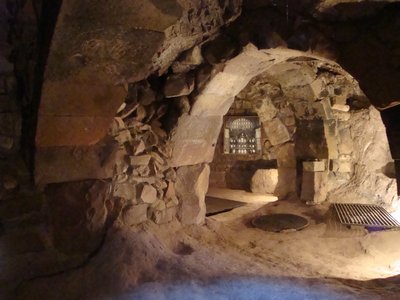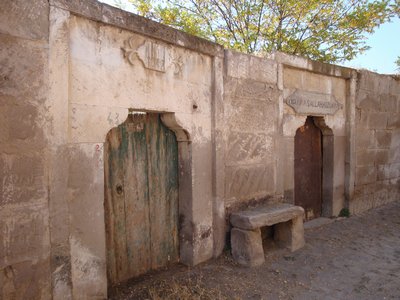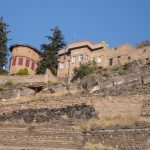So here I am in Kayseri on a lovely autumn day and I’m running round town like a blue-arsed fly trying to find out where the bus to Ağırnas leaves from. You’d think this would be easy, wouldn’t you? After all it’s not that long since a new museum on the supposed site of Sinan‘s family home was opened there to much fanfare. But while Kayseri has a lovely new intercity bus terminal it lacks that other sine qua non for easy traveling – a köy garaj or local bus terminal from which transport fans out to all the surrounding areas. Go this way, says one person. No, that way, says another. As you were, says a third. I’ve no idea at all, says a fourth.
Finally I find the stop, a parking lot behind the one from which the Develi buses leave that is right beside the big Melikgazi cemetery. The bus is standing disconsolately alone in the middle of the lot and since there’s no one in it I ask about departure times at a nearby booth. The police officer behind the desk has no idea. “Where are you from?” he asks me instead. When I decline to start down that tiresome conversational road he summons a friend who leads me back to the bus where it turns out I’d failed to spot the driver taking a nap at the back. It’s five to eleven. The bus goes at 11am. I’m in luck.
Ağırnas turns out to be 27 kilometres away, way out past the Kayseri boundaries along an increasingly wooded road that drops down into a valley and then pops back up again on the far side of it. But I make another mistake on arrival which is to fail to mention that I’ve come to see the museum (odd – you’d think it might occur to the driver that the only foreigners to venture this way are those in search of Sinan) which means that I’m taken on a magical mystery tour of what turns out to be a small town of 4,000 souls. When I finally ask about the museum the driver pulls out his phone and makes a call to a friend who then phones the zabita who boards the bus a little further down the road with the intention of showing me everything that Ağırnas has to offer.
Fair enough, I suppose, except that I loathe having to drag around with someone who will probably be more interested in quizzing me on my origins and my love of Turkey than in telling me anything I didn’t already known about the site. Grumpily I follow him to the house where he makes a great show of unlocking the door and then leaving me to it. I’d read that the museum was housed in a building that long postdated Sinan’s life but hadn’t realised that it stands above one of the underground cities for which Cappadocia is famous. This one has been pressed into service as somewhere to display photographs of Sinan’s best-known works. It’s a little too brightly lit but has all the familiar features of such places: rock-cut mangers, tandır ovens in the floor, soot-blackened walls. Only the impressive rolling stones used to seal off corridors are missing.
“Where does it go?” I ask the zabita who is, not surprisingly, unimpressed by me.
“There are tunnels down to it from all the houses,” he says, and around town I spot what certainly look like these tunnels, their approaches now busily collecting rubbish. Unexpectedly it reminds me of Nottingham in England where many of the houses also sit above rock-cut cellars that link up with one another.
The kitchen has been refitted to look much as it might have done in Sinan’s day, and the sitting areas are probably fairly accurate as well. It’s not a very large house and I see that the notice about Sinan himself is quiet about his probable Greek (or Armenian) origins. There are no translations in English either which seems an oversight although the only other visitors to show up while I’m there are two Turkish men.
Leaving the house, I take a sharp right and find myself strolling along a street of pretty stone houses, each with an impressively carved gateway. The dates are interesting; most of these houses date back only to the 1950s and 1960s despite their timeless air.
“You’ll have to pay if you want to take a picture of that gate,” calls a woman who is busy chopping firewood on a bluff.
“Then you’ll have to pay when you come to visit me in Göreme,” I reply and she guffaws with laughter. There’s a gargoyle in the shape of an animal jutting out from her house. “Who did that?” I ask.
“The mayor’s son,” says an older woman whom I take to be her mother.
On the main road I find a lovely fountain that feeds into a string of troughs and is still in active use by both villagers and passing stray dogs. There’s also an imposing schoolhouse that I presume pre-dates the population exchange of 1923 and that has a bust of Sinan in front of it. Then I go astray and find myself washed up amid the newer houses of Ağırnas just as the bus back to Kayseri is departing which means that I’m left with another two hours to while away and not much to do with them. Perhaps ten minutes go on inspecting a 19th-century church sans bell-tower that apparently serves as a cultural centre (had I not snubbed the zabita he would probably have unlocked it for me after he’d eaten his lunch). The portico is supported by marble columns that look as if they’ve come from an earlier Roman town but there’s nothing to tell me anything about the building beyond the fact that it was dedicated to St Procopius. I spin out another twenty minutes or so taking pictures of some more imposing mansions alongside the main road but that still leaves more than an hour to be passed in the park attached to the tea garden where the benches all come labelled “Temiz tutalım (Let’s keep it clean)” but where the ground is ankle-deep in litter. There’s not so much as a pideci in the way of places to eat here which means that eventually I’m forced to join the men on the terrace over a glass of çay.
Finally the bus returns and I heave a sigh of relief, not because Ağırnas wasn’t pleasant (it was) but because I have my heart set on an İskender kebap back in Kayseri. But for the third time today I’m about to get caught out. Again I fail to state my destination, assuming that the bus will return to its starting point. We are bumping along quite nicely and I’m ticking off all the familiar landmarks when all of a sudden instead of turning right towards the parking lot by the cemetery the bus veers left and starts heading back towards Ağırnas. I wander to the front of the bus to ask.
“You should have said you wanted the last stop,” the driver tells me sniffily. “It’s your fault. I’m not allowed to stop here or I get fined.” And so he drives round for another fifteen minutes before pulling up by the roadside in the middle of nowhere for another ten minutes. Only then does he drive back to the point where I’d recognised that something was going amiss and let me out. He does not return to the parking lot which means that that was probably not the official starting point either. Ağırnas was lovely and well worth the visit but if it wants to attract more foreign tourists it really is going to have to try harder on the transport front.
Written: 8 October 2011




1 Comment
Sounds like an intriguing place. I had a similar dolmuş experience last year, trying to get from Fethiye to Saklıkent Gorge in the off-season. I boarded the bus, asked for Saklıkent, seemingly no problem. After about an hour and a half of winding through local villages, I was about the last person still on board and the driver gave me a quizzical “Abla, nereye gidiyorsun?” Saklıkent, I told him again, and only then did he decide to tell me that there was no regular service *back* from the gorge, and that I would have to call the dolmuş driver to come pick me up. It boggled my mind a bit that he wouldn’t have figured a foreigner going to Saklıkent would be boarding the bus for any other reason than to see the gorge. I did get there and back eventually, though spent quite a bit of time drinking tea with the two bored guys working at the canyon entrance while waiting for my return ride to arrive!